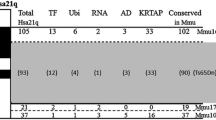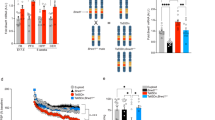Abstract
The segmental trisomy model, Ts65Dn, has been a valuable resource for the study of the molecular and developmental processes associated with the pathogenesis of Down syndrome. However, male infertility and poor transmission of the small marker chromosome, T(1716)65Dn, carrying the distal end of mouse Chromosome 16 (MMU16) are limiting factors in the efficient production of these animals for experimental purposes. We describe here the identification and preliminary characterization of mice, designated Ts[Rb(12.1716)]2Cje, carrying a chromosomal rearrangement of the Ts65Dn genome whereby the marker chromosome has been translocated to Chromosome 12 (MMU12) forming a Robertsonian chromosome. This stable rearrangement confers fertility in males and increases the frequency of transmitted segmental trisomy through the female germline. We confirm retention of a dosage imbalance of human Chromosome 21 (HSA21)-homologous genes from App to the telomere and expression levels similar to Ts65Dn within the triplicated region. In addition, we characterized the dendritic morphology of granule cells in the fascia dentata in Ts[Rb(12.1716)]2Cje and 2N control mice. Quantitative confocal microscopy revealed decreased spine density on the dendrites of dentate granule cells and significantly enlarged dendritic spines affecting the entire population in Ts[Rb(12.1716)]2Cje as compared to 2N controls. These findings document that the structural dendritic spine abnormalities are similar to those previously observed in Ts65Dn mice. We conclude that this new model of Down syndrome offers reproductive advantages without sacrificing the integrity of the Ts65Dn model.








Similar content being viewed by others
References
EC Akeson JP Lambert S Narayanswami K Gardiner LJ Bechtel et al. (2001) ArticleTitleTs56Dn–localization of the translocation breakpoint and trisomic gene content in a mouse model for Down syndrome Cytogenet Cell Genet 93 IssueID3–4 270–276 Occurrence Handle10.1159/000056997 Occurrence Handle1:CAS:528:DC%2BD3MXntVKhsro%3D Occurrence Handle11528125
PV Belichenko A Dahlström (1995) ArticleTitleStudies on the 3-dimensional architecture of dendritic spines variocosities in human cortex by confocal laser scanning microscopy and Lucifer yellow microinjections J Neurosci Methods 57 55–61 Occurrence Handle10.1016/0165-0270(94)00125-Z Occurrence Handle1:STN:280:ByqA3M7kslU%3D Occurrence Handle7791365
PV Belichenko E Masliah AM Kleschevnikov AJ Villar CJ Epstem et al. (2004) ArticleTitleSynaptic structural abnormalities in the Ts65Dn mouse model of Down syndrome J Comp Neurol 480 281–298 Occurrence Handle10.1002/cne.20337 Occurrence Handle15515178
SA Berend SL Page W Atkinson C McCaskill NE Lamb et al. (2003) ArticleTitleObligate short-arm exchange in de novo Robertsonian translocation formation influences placement of crossovers in chromosome 21 nondisjunction Am J Hum Genet 72 IssueID2 488–495 Occurrence Handle10.1086/367547 Occurrence Handle1:CAS:528:DC%2BD3sXht12rtLg%3D Occurrence Handle12506337
D Boehm S Herold A Kuechler T Liehr F Laccone (2004) ArticleTitleRapid detection of subtelomeric deletion/duplication by novel real-time quantitative PCR using SYBR-green dye Hum Mutat 23 IssueID4 368–378 Occurrence Handle10.1002/humu.20011 Occurrence Handle1:CAS:528:DC%2BD2cXjslGrs7g%3D Occurrence Handle15024731
MT Davisson EC Akeson (1987) ArticleTitleAn unproved method for preparing G-banded chromosomes from mouse peripheral blood Cytogenet Cell Genet 45 IssueID2 70–74 Occurrence Handle1:STN:280:BiiA3czhslE%3D Occurrence Handle3622012
MT Davisson AC Costa (1999) Mouse models of Down syndrome B Popko (Eds) Mouse Models of Human Genetic Neurological Diseases Plenum New York 297–327
MT Davisson C Schmidt RH Reeves NG Irving EC Akeson et al. (1993) Segmental trisomy as a model for Down syndrome CJ Epstein (Eds) The Phenotypic Mapping of Down Syndrome and Other Aneuploid Conditions Vol 384 Wiley-Liss New York 117–133
RM Escorihuela A Fernandez–Teruel IF Vallina C Baamonde InstitutionalAuthorNameLumbreras et al. (1995) ArticleTitleA behavioral assessment of Ts65Dn mice: a putative Down syndrome model Neurosci Lett 199 IssueID2 143–146 Occurrence Handle10.1016/0304-3940(95)12052-6 Occurrence Handle1:CAS:528:DyaK2MXptVems7s%3D Occurrence Handle8584244
M Hattori A Fujiyama TD Taylor H Watanabe T Yada et al. (2000) ArticleTitleChromosome 21 mapping and sequencing consortium. The DNA sequence of human chromosome 21 Nature 405 IssueID6784 311–319 Occurrence Handle10.1038/35012518 Occurrence Handle1:CAS:528:DC%2BD3cXjs1KlsL8%3D Occurrence Handle10830953
DM Holtzman D Santucci J Kilbridge J Chua–Couzens DJ Fontana et al. (1996) ArticleTitleDevelopmental abnormalities and age-related neurodegeneration in a mouse model of Down syndrome Proc Natl Acad Sci USA 93 IssueID23 13333–13338 Occurrence Handle10.1073/pnas.93.23.13333 Occurrence Handle1:CAS:528:DyaK28XmvFSnsLw%3D Occurrence Handle8917591
DP Liu C Schmidt T Billings MT Davisson (2003) ArticleTitleQuantitative PCR genotyping assay for the Ts65Dn mouse model of Down syndrome Biotechniques 35 IssueID6 1170–1174 Occurrence Handle1:CAS:528:DC%2BD3sXpvVart7o%3D Occurrence Handle14682051
Livak KJ (1997) Comparative Ct Method. ABI PRISM 7700 Sequence Detection System, User Bulletin No. 2, Relative quantitation of gene expression. PE Applied Biosystems, http://docs.appliedbiosystems.com/pebio-docs/04303859.pdf
RM Luche R Maiwald EJ Carlson CJ Epstein (1997) ArticleTitleNovel mutations in an otherwise strictly conserved domain of CuZn superoxide dismutase Mol Cell Biochem 168 191–194 Occurrence Handle10.1023/A:1006871524623 Occurrence Handle1:CAS:528:DyaK2sXhvValtLo%3D Occurrence Handle9062909
R Lyle C Gehrig C Neergaard–Henrichsen S Deutsch SE Antonarakis (2004) ArticleTitleGene expression from the aneuploid chromosome in a trisomy mouse model of Down syndrome Genome Res 14 IssueID7 1268–1274 Occurrence Handle10.1101/gr.2090904 Occurrence Handle1:CAS:528:DC%2BD2cXlvFWjtr4%3D Occurrence Handle15231743
MB Pulsifer (1996) ArticleTitleThe neuropsychology of mental retardation J Int Neuropsychol Soc 2 IssueID2 159–176 Occurrence Handle1:STN:280:DyaK1c%2Fkt1Oksg%3D%3D Occurrence Handle9375201
RH Reeves NG Irving TH Moran A Wohn C Kitt et al. (1995) ArticleTitleA mouse model for Down syndrome exhibits learning and behavioral deficits Nat Genet 11 177–184 Occurrence Handle10.1038/ng1095-177 Occurrence Handle1:CAS:528:DyaK2MXosF2rtrg%3D Occurrence Handle7550346
C Ruiz–Ponte L Loidi A Vega A Carracedo F Barros (2000) ArticleTitleRapid real-time fluorescent PCR gene dosage test for the diagnosis of DNA duplications and deletions Clin Chem 46 IssueID10 1574–1582 Occurrence Handle1:CAS:528:DC%2BD3cXnsFOhtLs%3D Occurrence Handle11017934
H Sago EJ Carlson DJ Smith J Kilbridge EM Rubin et al. (1998) ArticleTitleTs1Cje, a partial trisomy 16 mouse model for Down syndrome, exhibits learning and behavioral abnormalities Proc Natl Acad Sci USA 95 IssueID11 6256–6261 Occurrence Handle10.1073/pnas.95.11.6256 Occurrence Handle1:CAS:528:DyaK1cXjtlKns7g%3D Occurrence Handle9600952
H Sago EJ Carlson DJ Smith EM Rubin LS Crnic et al. (2000) ArticleTitleGenetic dissection of the region associated with behavioral abnormalities in mouse models for Down syndrome Pediatr Res 48 IssueID5 606–613 Occurrence Handle1:CAS:528:DC%2BD3cXot1Sqsr4%3D Occurrence Handle11044479
E Schaeffeler M Schwab M Eichelbaum UM Zanger (2003) ArticleTitleCYP2D6 genotyping strategy based on gene copy number determination by TaqMan real-time PCR Hum Mutat 22 IssueID6 476–485 Occurrence Handle10.1002/humu.10280 Occurrence Handle1:CAS:528:DC%2BD2cXps1Oh Occurrence Handle14635107
K Wilke B Duman J Horst (2000) ArticleTitleDiagnosis of haploidy and triploidy based on measurement of gene copy number by real-time PCR Hum Mutat 16 IssueID5 431–436 Occurrence Handle10.1002/1098-1004(200011)16:5<431::AID-HUMU8>3.0.CO;2-Z Occurrence Handle1:CAS:528:DC%2BD3cXoslGlsLs%3D Occurrence Handle11058901
Acknowledgments
This work was supported by NIH grants AG16999, HD31498, and NS38869 and grants from the Hillblom Foundation and the Down Syndrome Research and Treatment Foundation at Stanford University. We thank Muriel Davisson for helpful advice and R. Gacayan and M. Doan for excellent animal care. Technical expertise and real-time quantitative PCR were provided by Katie Clark and Jennifer Weston of the Biomolecular Resource Center at the University of California, San Francisco.
Author information
Authors and Affiliations
Corresponding author
Rights and permissions
About this article
Cite this article
Villar, A.J., Belichenko, P.V., Gillespie, A.M. et al. Identification and characterization of a new Down syndrome model, Ts[Rb(12.1716)]2Cje, resulting from a spontaneous Robertsonian fusion between T(1716)65Dn and mouseChromosome 12. Mamm Genome 16, 79–90 (2005). https://doi.org/10.1007/s00335-004-2428-7
Received:
Accepted:
Issue Date:
DOI: https://doi.org/10.1007/s00335-004-2428-7




